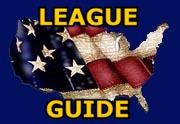BUCK MILLER V
Buck Miller V – Modern, AIM, DH/non-DH, Draft League Manager
(1) Miller V does NOT save a rotation; you MUST bench your starters to prevent their use in relief. Miller V will use any pitcher that is not benched regardless of their grade, rating or stats (e.g., any relief appearances).
(2) Miller V (like prior versions) is NOT designed for historic or season replays. They are designed solely for draft league games. Use of the Miller managers in a historic season will lead to odd results or stats.
Buck Miller V is designed to handle modern draft league only replays. He is not designed to manage season replays of any type. Although created to guide modern seasons, he may be adequate in handling pre-modern (e.g, 1990) replays depending on your team’s roster.
Several important points to make:
– Buck Miller V is nearly an identical version of Buck Miller IV with the critical exception of using closers late when a team’s bullpen is depleted (note: there are a few other slight changes affecting this).
– For the closer usage changes, Miller I-IV were programmed not to use a team’s closer (or top reliever) unless the team had at least one other available reliever to use. This was to prevent those rare but problematic situations where a closer blows a save, the game is tied, and then that stud reliever has to finish the game out. That would lead sometimes to 3-4-5 or more innings in relief, exhausing the pitcher’s RR and forcing him to rest an additional 2-4+ days.
– Miller V will, however, use a closer – even if no other reliever is available – late (8th or 9th) in a save situation IF the starter’s RR is 0 or lower or if there’s a very heavy grade advantage (5 or more).
– Miller V, like the other Miller programs, uses a quick modern hook with his starters especially in either save situations or with safe leads late. He selects closers late by adjusted grades (grade plus or minus control ratings)). Normal closers will be those with adjusted grades of between 13 and 16. Super type closers (e.g., a Rivera) will have 17 plus grades.
– For the most part, he will use closers for one inning; however in critical situations (2 runners on, one or more outs, in the eighth) he will spot the closer for a inning+ of work. Additionally, if the closers have low QRs (2/1) they will also be used for multiple innings (usually a maximum of 2).
– Remember, RRs are important as well. Setup relievers are heavily employed, especially with platoon advantages. One batter relief specialist (e.g, average less than one inning per outing) are also used.
– Low inning starters will be pulled quickly to save their innings. Also, with safe leads, starters will be yanked especially if the bullpen is strong and/or itchy relievers need outings. Note: a tough area to program is middle or long relief. If your team doesn’t have a long reliever type (e.g, QR of 2/1), Miller I-V will try and rotate several short relief types (low grades/saves) for early-to-mid inning outings.
– Both steal and H&R are steal chance driven. Stealing is limited to 100% or historic totals.
– Bunting is quite limited to low power/average hitters early; little more aggressive late in critical situations. SO per AB and SH per AB are critical factors in bunting (other factors are also considered).
– Aggressive PHing with platoon disadvantages. Will PH to pad lead late (but not for best defensive players); for DH with platoon disadvantage; for a better H&R; to bunt late; for an announced PHer against a new pitcher with a platoon advantage.
– Aggressive subbing in blowouts; DS, PH for star players, PR for stars and subbing defensively will be seen.
– Base advancement based on advance chances (internal number provided by game plus OF/Inf arm plus speed).







